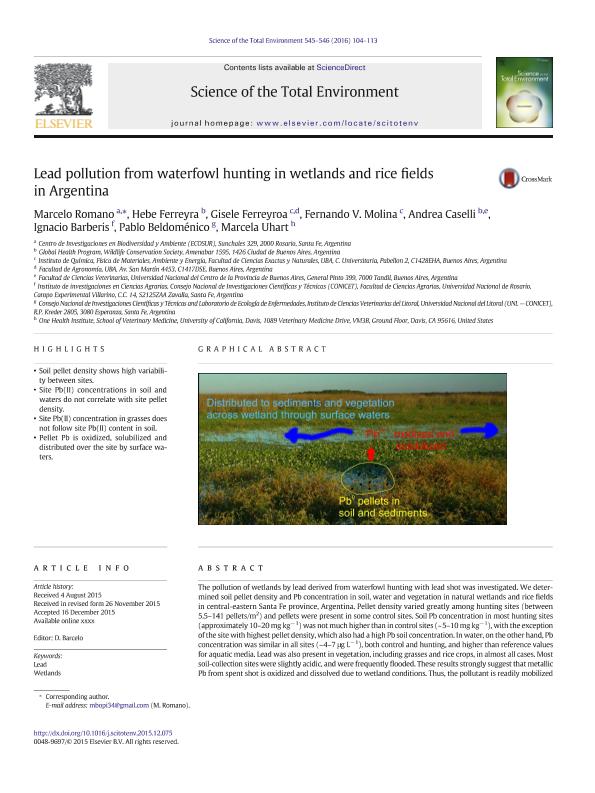Artículo
Lead pollution from waterfowl hunting in wetlands and rice fields in Argentina
Romano, Marcelo; Ferreyra, Hebe; Ferreyroa, Gisele Veronica ; Molina, Fernando Víctor
; Molina, Fernando Víctor ; Caselli, Andrea; Barberis, Ignacio Martín
; Caselli, Andrea; Barberis, Ignacio Martín ; Beldomenico, Pablo Martín
; Beldomenico, Pablo Martín ; Uhart, Marcela
; Uhart, Marcela
 ; Molina, Fernando Víctor
; Molina, Fernando Víctor ; Caselli, Andrea; Barberis, Ignacio Martín
; Caselli, Andrea; Barberis, Ignacio Martín ; Beldomenico, Pablo Martín
; Beldomenico, Pablo Martín ; Uhart, Marcela
; Uhart, Marcela
Fecha de publicación:
03/2016
Editorial:
Elsevier Science
Revista:
Science of the Total Environment
ISSN:
0048-9697
Idioma:
Inglés
Tipo de recurso:
Artículo publicado
Clasificación temática:
Resumen
The pollution of wetlands by lead derived from waterfowl hunting with lead shot was investigated. We determined soil pellet density and Pb concentration in soil, water and vegetation in natural wetlands and rice fields in central-eastern Santa Fe province, Argentina. Pellet density varied greatly among hunting sites (between 5.5-141 pellets/m2) and pellets were present in some control sites. Soil Pb concentration in most hunting sites (approximately 10-20mgkg-1) was not much higher than in control sites (~5-10mgkg-1), with the exception of the site with highest pellet density, which also had a high Pb soil concentration. In water, on the other hand, Pb concentration was similar in all sites (~4-7μgL-1), both control and hunting, and higher than reference values for aquatic media. Lead was also present in vegetation, including grasses and rice crops, in almost all cases. Most soil-collection sites were slightly acidic, and were frequently flooded. These results strongly suggest that metallic Pb from spent shot is oxidized and dissolved due to wetland conditions. Thus, the pollutant is readily mobilized and distributed across all wetland areas, effectively homogenizing its concentration in locations with and without hunting activities. The replacement of lead by nontoxic materials in pellets appears to be the only effective way to prevent Pb pollution in wetlands.
Palabras clave:
Environmental Pollution
,
Hunting
,
Lead
,
Trace Metals
,
Wetlands
Archivos asociados
Licencia
Identificadores
Colecciones
Articulos(ICIVET-LITORAL)
Articulos de INST. DE CIENCIAS VETERINARIAS DEL LITORAL
Articulos de INST. DE CIENCIAS VETERINARIAS DEL LITORAL
Articulos(INQUIMAE)
Articulos de INST.D/QUIM FIS D/L MATERIALES MEDIOAMB Y ENERGIA
Articulos de INST.D/QUIM FIS D/L MATERIALES MEDIOAMB Y ENERGIA
Citación
Romano, Marcelo; Ferreyra, Hebe; Ferreyroa, Gisele Veronica; Molina, Fernando Víctor; Caselli, Andrea; et al.; Lead pollution from waterfowl hunting in wetlands and rice fields in Argentina; Elsevier Science; Science of the Total Environment; 545-546; 3-2016; 104-113
Compartir
Altmétricas



